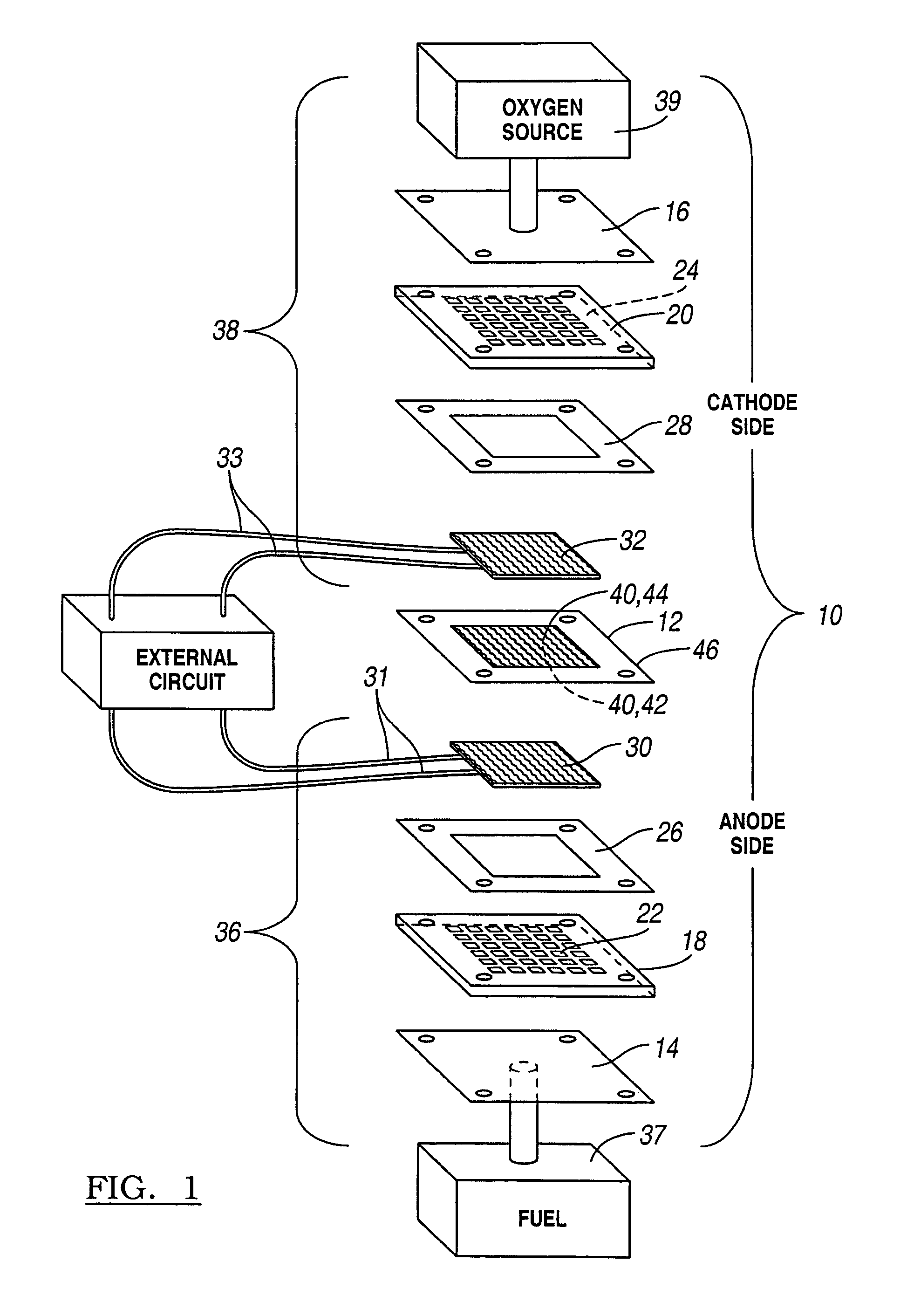Fuel cell assembly
a fuel cell and assembly technology, applied in the field of fuel cells, can solve the problems of power output and useful life decline, and achieve the effects of improving dimensional stability, improving proton transport, and ensuring stability
- Summary
- Abstract
- Description
- Claims
- Application Information
AI Technical Summary
Benefits of technology
Problems solved by technology
Method used
Image
Examples
example 1
[0039]The nanocomposite membranes were prepared from 5 wt. % NAFION® perfluorinated resin solution containing lower aliphatic alcohols and 15-20% water. Sodium exchanged montmorillonite clay, CLOISITE® Na+ clay, was added to the commercially available NAFION® polymer solution and diluted with methanol to yield the equivalent of a 6 wt. % clay reinforced NAFION® thin film when the solvents were later flashed-off at room temperature. Before flash-off of solvent, the mixtures were sonicated for six hours to exfoliate the clay particles. Then the clay and polymer solution casts onto two inch silicon wafers with an Integrated Technologies P6000 spin coater rotated at 500 rpm for 3 seconds. Specifications of the clay as used herein are given below.
[0040]For comparison, thin films of NAFION® without the clay particles were also cast onto silicon wafers from the undiluted solution. See Comparative Example below.
[0041]The nanocomposite membranes prepared by the method have a thickness of abo...
example 2
[0044]111 NAFION® films were spin-cast containing 3, 6, 9 and 12 wt. % montmorillonite clay reinforcement. Appropriate masses of clays were added to a 15 ml. NAFION®-20 ml methanol solution and sonicated for 48 hours. Alternatively, similar solutions were prepared to achieve the same concentrations of clay and high shear mixed for less than 10 minutes (longer high shear mixing damages the NAFION®). The mixed solutions were then spin-cast into two inch silicon wafer at less than 200 rpm and allowed to flash-off the methanol at room temperature.
example 3
[0045]Further composite membranes were prepared using starting materials and methods as per Example 1 and Example 2 above, except that exfoliation of the clay was conducted before combing the clay with the polymer. This better preserved the character of the polymer, preventing fragmentation or damage to the polymer.
[0046]Specification of Na+MM:
[0047]CLOISITE® Na+ is a natural montmorillonite available from Southern Clay Products, Inc., 1212 Church Street Gonzales, Tex. 78629 USA. The properties of the clay, as used, are given below.
[0048]Typical properties of CLOISITE® Na+ are: no organic modifier; cation exchange capacity of 92.6 meq / 100 g clay; and <2% moisture.
[0049]Typical dry particle sizes in microns, by volume, are: 10% less than 2μ; 50% less than 6μ; and 90% less than 13μ (micrometers).
[0050]The density is as follows: loose bulk is 12.45 lbs / ft3; packed bulk is 20.95 lbs / ft3; and specific gravity is 2.86 g / cc.
[0051]X-ray results are d001=11.7 Å.
PUM
| Property | Measurement | Unit |
|---|---|---|
| thick | aaaaa | aaaaa |
| temperatures | aaaaa | aaaaa |
| thickness | aaaaa | aaaaa |
Abstract
Description
Claims
Application Information
 Login to View More
Login to View More - R&D
- Intellectual Property
- Life Sciences
- Materials
- Tech Scout
- Unparalleled Data Quality
- Higher Quality Content
- 60% Fewer Hallucinations
Browse by: Latest US Patents, China's latest patents, Technical Efficacy Thesaurus, Application Domain, Technology Topic, Popular Technical Reports.
© 2025 PatSnap. All rights reserved.Legal|Privacy policy|Modern Slavery Act Transparency Statement|Sitemap|About US| Contact US: help@patsnap.com



